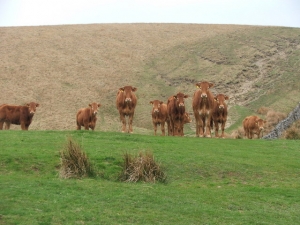Dairy Management
Calculating Operating Profit on a Dairy Farm

To get up to date figures for adjustments refer to the DairyBase website and navigate to the “Reference Material” page where you will find a hotlink to the latest adjustments under the “Miscellaneous” heading.
Value of Change in Dairy Livestock
If stock numbers change between the start of one season, and the start of the next, this will affect stock income for the year.
- If stock numbers go up then less stock will have been sold than usual. Stock income will be lower than usual, and we adjust Operating Profit up.
- If stock numbers go down income will be higher than usual, and we adjust Operating Profit down.
Such movements make comparison of Operating Profit between years and between farms difficult.
Therefore an adjustment is made to smooth the differences. The value of the change in livestock numbers adjustment is calculated using National Average Market Values and is completed for each stock class. The calculation used is:
Closing numbers of dairy livestock – opening numbers of dairy livestock x closing National Average Market Values
Calculate the stock adjustment for your farm using the following table. 
Note Make sure you transfer the negative sign (-) to the calculation sheet where a negative occurs.
Runoffs or Where Young Stock are Grazed at Home
If you lease a runoff or graze off, then no adjustment is needed – costs appear in your accounts already (Grazing and Run-off).
- People with run-off land will not have the full costs associated with the additional feed grown on the run-off or grazed by dry cows and young stock. The run-off adjustment is used in these cases to create the equivalent of a lease
- The runoff adjustment is either an estimate of the market rate to lease the land for dry stock or the default values as detailed in the table below. If you own a runoff, adjust the Operating Profit down for the value of that land to you.
Calculate your Runoff Adjustment Here
Labour Adjustment
All unpaid labour is valued when calculating the Operating Profit
Some farms are managed by people who receive no direct payment for their work through the farm working expenses in their financial accounts, in other words they take drawings. Other farms employ a manager and/or staff to run the farm, whose wages do appear in the financial accounts. This can result in a significant difference in wage expenses for otherwise very similar farms. Drawings cannot be used as a reliable indicator of the value of the labour provided due to people’s different standards of living.
The value of the unpaid labour adjustment is calculated based on a differential rate for wages to the primary manager of the business and other unpaid labour involved in operations rather than management.
Wage for Management (a)
- If the principal farm manager is employed, then the wage cost of the manager will already be in the accounts. No wage for management is needed. This should not include director’s fees or shareholder salaries.
- If the farm manager is also the farm owner or 50:50 sharemilker, you need to include a wage for management in the Operating Profit, to value the labour of that person.
Wages for Management are based on the Number of Peak Cows Milked
Use the number of Peak Cows Milked to calculate the appropriate wages of management.
The management adjustment is based on hours worked with 2,400 hrs/year for one full time equivalent (FTE) manager. Where the hours worked are greater than 2,400 hours/year the hours over and above 2,400 for the manager are calculated at the family unpaid hourly rate as detailed in the table below up to 3,600 hours. Over 3,600 hours per annum there is no further adjustment. These rates are also used for additional family labour.
Year Annual Rate Hourly Rate
For example, In 2008/09 where one unpaid family manger works 60hrs/week on average as the primary manager, and a second works 20 hours per week assisting with milking a 500 cow herd the adjustment for unpaid labour would be:
Calculate your labour adjustment
Feed Inventory Adjustment
- This is a financial adjustment for the change in supplementary feed held on hand at the start of each season. This is calculated by taking the Closing supplementary feed (dry matter tonnes) less Opening supplementary feed (dry matter tonnes) and multiplying by the value of the feed $/tonne dry matter as per the table below.
Note: Make sure you transfer the negative sign (-) to the calculation sheet where a negative occurs.






























